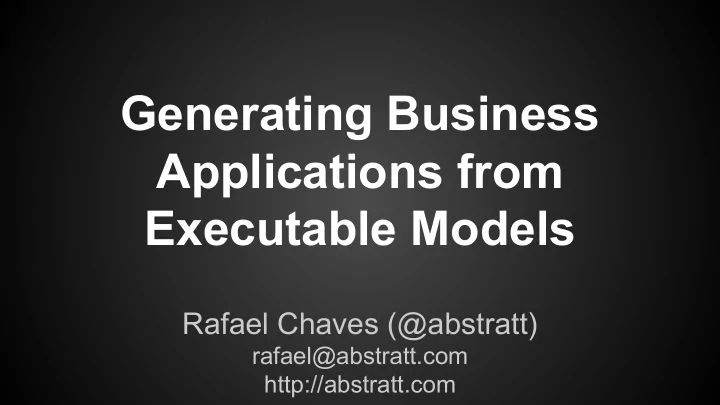

Generating Business Applications from Executable Models Rafael Chaves (@abstratt) rafael@abstratt.com http://abstratt.com
Motivation
Business applications Domain knowledge + Applied technology
How it should be...
Persistence Integration Serialization Security Domain knowledge Programming language Communication Transactions Caching protocols Memory management Concurrency
How it usually goes...
Persistence Integration Serialization Security Domain knowledge Programming language Communication Transactions Caching protocols Memory management Concurrency
Executable models to the rescue
Executable models are models but... Precise (as much as needed) Complete (about what matters)
Executable models are programs but... Focused (on problem domain concepts) Oblivious (regarding technological choices)
Executable models promote a complete separation between business and technology
Entities Relationships Constraints Operations and queries States Domain knowledge Events (synthesized by programmer) Services Roles Persistence Authentication Querying Backups Architecture Authorization Scaling (applied automatically REST API Email notifications by platform or code Text search Usage-based billing generator) Integration Payment processing User interface Prog. language Logging
Demonstration
Tools ● vanilla UML as executable modeling language ○ extended via profiles/conventions ● TextUML - textual notation over UML ● Eclipse Xtend - for implementing generators ● Cloudfier - web-based modeling IDE with interpreter/generators General concepts > Particular tools
Modeling
Test-driven modeling
User-driven validation
Code generation
Structure-based generation Classes Attributes Operations (signatures) Associations Other classifiers (enumerations, signals etc) Default values/derivations
State machine-based generation States Transitions Triggers Guards Entry/exit/do activities
Activity-based generation Activities Actions Input and output pins Object flows
Available actions ● structured node (blocks) ● read/write variable ● test identity ● create/destroy object ● conditional (if/switch) ● read self ("this") ● loop (for/while) ● read/write attribute ● raise exception ● create/destroy link ● send signal ● call operation
operation deposit(depositedAmount : Decimal) { this.balance = this.balance + depositedAmount; }
Plain Java Plain Javascript
Lessons learned
Knowing the target platform matters ● Better to know what the destination looks like before you start ● At a minimum, have fully-functional handwritten example code
Pick your generator language wisely ● Java ○ full power, but awkward with collections (improved in 1.8), no string interpolation ● StringTemplate ○ standalone templates, but less control ● Groovy ○ graph navigation/transformation, string interpolation ● Xtend ○ plus static type checking, IDE support
Testing the generator ● have sample applications covering all modeling language features ○ use a compiler/lint to check for syntactical errors ● have tests in your sample apps ○ generate then run tests to detect runtime/integration problems
Generator Reuse ● within a platform (Plain Java, JPA-enabled) ○ share base templates, differ on details ● across target platforms ○ reasoning about models is often the same ● design reuse helps too ○ second generator is much easier
References Blog http://abstratt.com/blog/ Executable UML http://www.executableumlbook.com/ http://www.omg.org/spec/FUML/ http://www.omg.org/spec/ALF/ Cloudfier/TextUML http://doc.cloudfier.com - http://github.com/abstratt/cloudfier http://abstratt.com/textuml
Status ● JavaEE generator under active development (open-source EPL) (dev. started on Feb. 18) ● MEAN generator in the back burner ● Looking for sponsors / contracts to further develop the generators ● Cloudfier is still alpha, you are welcome to try it
Evaluate the sessions Sign in: www.eclipsecon.org +1 0 -1
Generating Business Applications from Executable Models Rafael Chaves (@abstratt) rafael@abstratt.com http://abstratt.com
Recommend
More recommend